BY JANET STEINBERG
Buon giorno. Good morning. Having
received port clearance in Civitavecchia, Italy, folllowing my Mediterranean
cruise, I opted for a sightseeing tour in Civitavecchio and a post-cruise
stay in the Eternal City of Rome.
received port clearance in Civitavecchia, Italy, folllowing my Mediterranean
cruise, I opted for a sightseeing tour in Civitavecchio and a post-cruise
stay in the Eternal City of Rome.
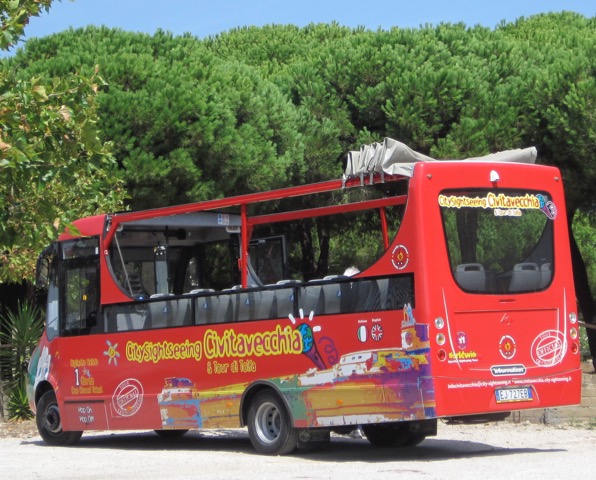 |
| SIGHTSEEING BUS IN CIVITAVECCHIA |
An hour-plus drive took us through
the Etruscan countryside, along the Via Aurelia, to Rome. Rome…that
magical city of overwhelming riches and enormous poverty…where traffic flows
like Chianti and cars are lethal weapons…where it’s easy to be pick-pocketed,
but difficult to be bored.
The
enormous Roman Coliseum (or Colosseum), 137-feet high and 1,580 feet in
circumference, once abounded with 50,000 spectators watching men being
thrown to the lions. The Coliseum took its name from a colossal statue of Nero
situated nearby. About the Coliseum Lord Byron wrote: “While stands the
Colosseum, Rome shall stand. When falls the Colosseum, Rome shall
fall. And when Rome falls—the world.” Today this arena,
completed in the year 80 AD, abounds with tourists and hundreds of cats that
call the place home.
enormous Roman Coliseum (or Colosseum), 137-feet high and 1,580 feet in
circumference, once abounded with 50,000 spectators watching men being
thrown to the lions. The Coliseum took its name from a colossal statue of Nero
situated nearby. About the Coliseum Lord Byron wrote: “While stands the
Colosseum, Rome shall stand. When falls the Colosseum, Rome shall
fall. And when Rome falls—the world.” Today this arena,
completed in the year 80 AD, abounds with tourists and hundreds of cats that
call the place home.
 |
| ROMAN COLOSSEUM |
The
Spanish Steps (Scalinata di Spagna) and the Piazza di Spagna at
the foot of The Steps, both get their name from the Spanish Embassy to the
Vatican that is located in the piazza. Built with French
money in the 1720s, the tiers of steps lead to the French church Trinita
dei Monti at the top of the steps.
Spanish Steps (Scalinata di Spagna) and the Piazza di Spagna at
the foot of The Steps, both get their name from the Spanish Embassy to the
Vatican that is located in the piazza. Built with French
money in the 1720s, the tiers of steps lead to the French church Trinita
dei Monti at the top of the steps.
 |
| SPANISH STEPS |
On
the piazza at the base of the Spanish Steps is Barcaccia a
boat-shaped fountain by Pietro Bernini, father of the renowned sculptor Gian
Lorenzo Bernini. Running perpendicular to the foot of the Spanish Steps
is Via Condotti, one of Rome’s most exclusive shopping
streets. Other streets in the immediate area, including the
mile-long Via del Corso, merge to form Rome’s most famous shopping area.
the piazza at the base of the Spanish Steps is Barcaccia a
boat-shaped fountain by Pietro Bernini, father of the renowned sculptor Gian
Lorenzo Bernini. Running perpendicular to the foot of the Spanish Steps
is Via Condotti, one of Rome’s most exclusive shopping
streets. Other streets in the immediate area, including the
mile-long Via del Corso, merge to form Rome’s most famous shopping area.
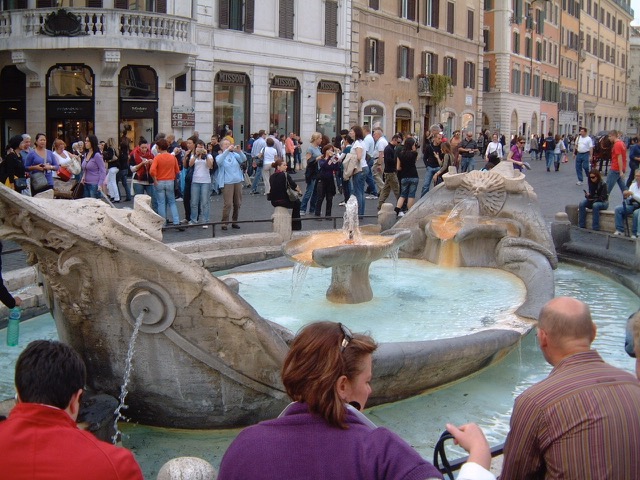 |
| THE BOAT-SHAPED FOUNTAIN”BARCACCIA” |
Citta
Vaticano (Vatican
City) is an independent sovereign state within the Italian Republic. The State
has its own citizenship, flag, diplomatic corps, newspaper, railroad station
and broadcasting system. It issues its own postage stamps and
currency, and it is the seat of the central government of the Roman Catholic
Church. Vatican City includes the Papal Palace, Saint Peters Church, Sistine
Chapel (with Michelangelo’s famed ceiling fresco), Vatican Library, Vatican Gardens,
many museums, many tourists, and many pickpockets.
Vaticano (Vatican
City) is an independent sovereign state within the Italian Republic. The State
has its own citizenship, flag, diplomatic corps, newspaper, railroad station
and broadcasting system. It issues its own postage stamps and
currency, and it is the seat of the central government of the Roman Catholic
Church. Vatican City includes the Papal Palace, Saint Peters Church, Sistine
Chapel (with Michelangelo’s famed ceiling fresco), Vatican Library, Vatican Gardens,
many museums, many tourists, and many pickpockets.
 |
| VATICAN CITY |
The
Trevi Fountain, built for Pope Clemente XII on a wall of the Palazzo Poli (The
Poli Palace), was completed in 1762. This spectacular white marble,
mythical fantasy is a sculptural masterpiece that has been immortalized through
paintings and movies such as “La Dolce Vita” and “Three Coins in the
Fountain”. Tradition has it that if you throw a coin over your left
shoulder, into the cascading waters of the fountain, you will return to
Rome. I did…I have…and I will.
Trevi Fountain, built for Pope Clemente XII on a wall of the Palazzo Poli (The
Poli Palace), was completed in 1762. This spectacular white marble,
mythical fantasy is a sculptural masterpiece that has been immortalized through
paintings and movies such as “La Dolce Vita” and “Three Coins in the
Fountain”. Tradition has it that if you throw a coin over your left
shoulder, into the cascading waters of the fountain, you will return to
Rome. I did…I have…and I will.
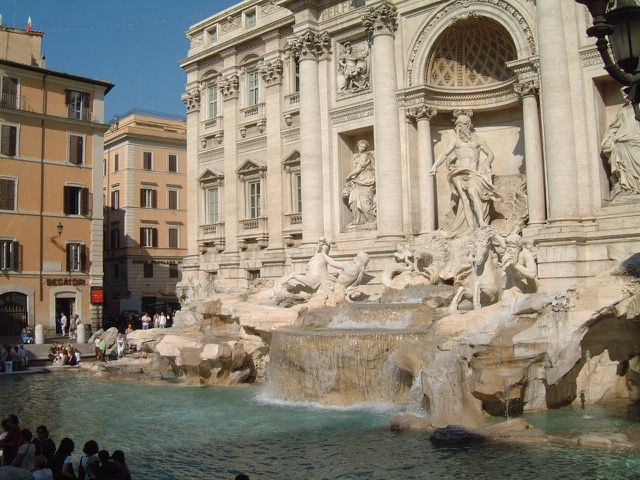 |
| TREVI FOUNTAIN |
Vatican
City’s absolute ruler may be The Pope, but many of the Italian men who sell
religious cameos in St. Peter’s Square are Jewish merchants. These
super salesmen are not averse to getting your attention by shouting out some
Yiddish words in Vatican Square.
City’s absolute ruler may be The Pope, but many of the Italian men who sell
religious cameos in St. Peter’s Square are Jewish merchants. These
super salesmen are not averse to getting your attention by shouting out some
Yiddish words in Vatican Square.
Many
tours in Rome include a visit to the Christian catacombs just outside the city
gates. It’s a worthwhile stop. However, if time permits,
you might also visit the Jewish catacombs along the Apian Way. These
burial sites, once under the jurisdiction of the Vatican, have been under the
authority of the Italian government since 1984.
tours in Rome include a visit to the Christian catacombs just outside the city
gates. It’s a worthwhile stop. However, if time permits,
you might also visit the Jewish catacombs along the Apian Way. These
burial sites, once under the jurisdiction of the Vatican, have been under the
authority of the Italian government since 1984.
In
this city of 900 churches, it is the Great Synagogue of Rome to which many
visitors head as they approach the city. This imposing structure, with its
square-base domed cupola, was designed by Christian architects at the turn of
the 20th century.Within the synagogue is the Jewish Museum of
Rome that features exhibits depicting “Two Thousand Years of Jewish History” as
well as Talmudic references to Italian Jewry and a collection of beautiful
Torah covers.
this city of 900 churches, it is the Great Synagogue of Rome to which many
visitors head as they approach the city. This imposing structure, with its
square-base domed cupola, was designed by Christian architects at the turn of
the 20th century.Within the synagogue is the Jewish Museum of
Rome that features exhibits depicting “Two Thousand Years of Jewish History” as
well as Talmudic references to Italian Jewry and a collection of beautiful
Torah covers.
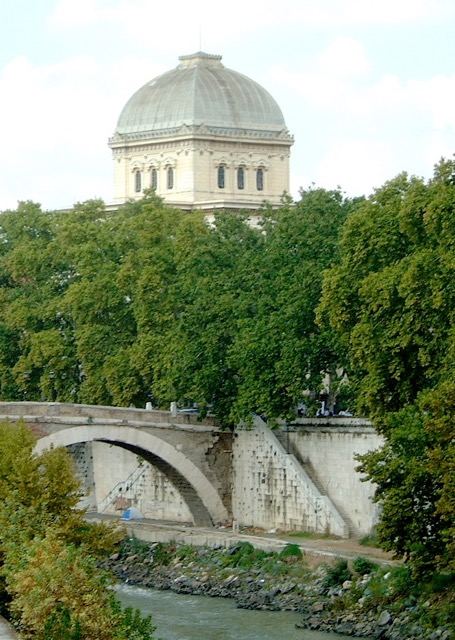 |
| GREAT SYNAGOGUE OF ROME’S SQUARE-BASED DOMED CUPOLA |
Bullet holes on the backside of the synagogue are a
somber reminder of the Arab terrorist attack in October 1982. Four
years later, in 1986, Pope John Paul II visited the sanctuary and told the
Jewish community: “You are our dearly beloved brothers and, in a certain way,
it could be said that you are our elder brothers.”
somber reminder of the Arab terrorist attack in October 1982. Four
years later, in 1986, Pope John Paul II visited the sanctuary and told the
Jewish community: “You are our dearly beloved brothers and, in a certain way,
it could be said that you are our elder brothers.”
Diagonally across from the synagogue, little remains
of the Church of St. Gregory, remembered in history as one of the churches
where Jews were forced to listen to conversion services during the Middle
Ages. Both Hebrew and Latin words were inscribed across the top of
the church door.
of the Church of St. Gregory, remembered in history as one of the churches
where Jews were forced to listen to conversion services during the Middle
Ages. Both Hebrew and Latin words were inscribed across the top of
the church door.
Just
behind the synagogue is the ancient ghetto where Jews were
once forced to live. Bound by the major shopping street called Via
Portico d’Ottavia, the ghetto is now frequented by both Jews and Gentiles.
Melding history, Jewish tradition and architecture, the ghetto abounds with
restaurants, clothing shops, butcher shops, and bakeries.
behind the synagogue is the ancient ghetto where Jews were
once forced to live. Bound by the major shopping street called Via
Portico d’Ottavia, the ghetto is now frequented by both Jews and Gentiles.
Melding history, Jewish tradition and architecture, the ghetto abounds with
restaurants, clothing shops, butcher shops, and bakeries.
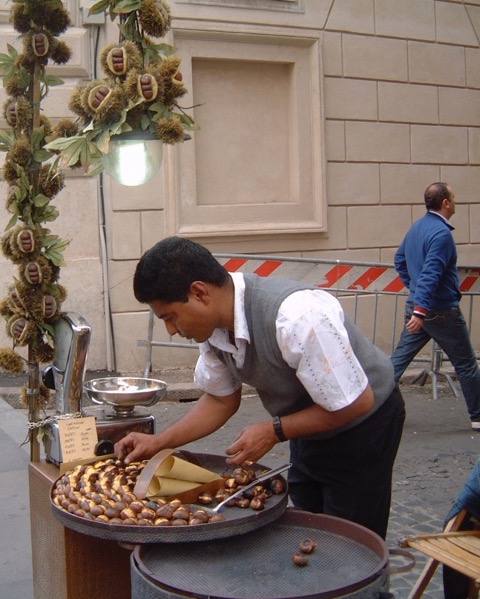 |
| YOU’LL NEVER GO HUNGRY IN ROME |
Adjacent
to the Portico (gate) d’Ottavia, Restaurant Da Giggetto, has been a favorite in
the old ghetto since Luigi Ceccarelli (nicknamed Giggetto) took it over right
after WWI. From 1923 onwards, it became famous for its Frascati
wines and remarkable dishes such as the longtime favorite, Carciofi
alla Giudea (artichokes in the Jewish style). Restaurant Da Giggetto’s
ambiance is old ghetto. Its clientele is new gourmand.
to the Portico (gate) d’Ottavia, Restaurant Da Giggetto, has been a favorite in
the old ghetto since Luigi Ceccarelli (nicknamed Giggetto) took it over right
after WWI. From 1923 onwards, it became famous for its Frascati
wines and remarkable dishes such as the longtime favorite, Carciofi
alla Giudea (artichokes in the Jewish style). Restaurant Da Giggetto’s
ambiance is old ghetto. Its clientele is new gourmand.
A
ten-minute walk from the ghetto is The Roman Forum. At the foot of
Capitoline hill, The Forum was the center of political and religious life in
ancient Rome. It was here that Rome’s great orators and philosophers met
to discuss the events of the day.
ten-minute walk from the ghetto is The Roman Forum. At the foot of
Capitoline hill, The Forum was the center of political and religious life in
ancient Rome. It was here that Rome’s great orators and philosophers met
to discuss the events of the day.
When
you’ve had enough sightseeing, head for the elegant Borghese Gardens, the most
ancient park in Europe. Relax by the lake as rowers weave their way
around geese, ducks, and swans in the mirror-like lake that reflects the Temple
of Aesculapius.
you’ve had enough sightseeing, head for the elegant Borghese Gardens, the most
ancient park in Europe. Relax by the lake as rowers weave their way
around geese, ducks, and swans in the mirror-like lake that reflects the Temple
of Aesculapius.
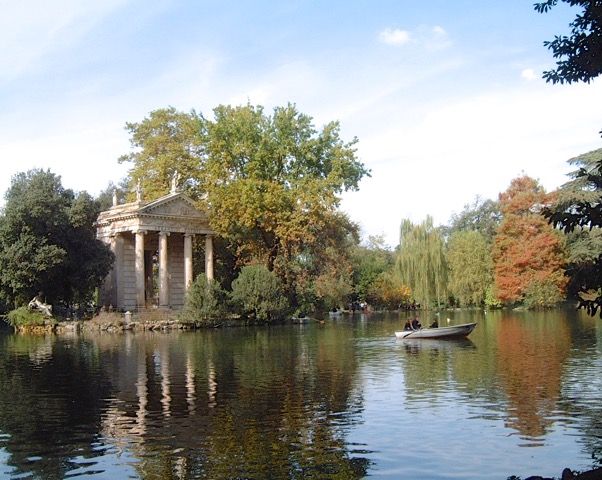 |
|
THE
TEMPLE OF AESCULAPIUS REFLECTS IN THE LAKE IN BORGHESE GARDENS |
Shhhhh! If you promise not to tell
anybody, I’ll let you in on a little 3-word secret… Hotel Lord
Byron. A short walk from the Borghese Gardens in the upscale Parioli
neighborhood of Rome, this Art Deco, 5-star jewel exudes the elegant atmosphere
of an old patrician villa. This 32-room hotel offers serenity,
discretion, art, and impeccable service, all at a more affordable price than
most other 5-star hotels in Rome.
anybody, I’ll let you in on a little 3-word secret… Hotel Lord
Byron. A short walk from the Borghese Gardens in the upscale Parioli
neighborhood of Rome, this Art Deco, 5-star jewel exudes the elegant atmosphere
of an old patrician villa. This 32-room hotel offers serenity,
discretion, art, and impeccable service, all at a more affordable price than
most other 5-star hotels in Rome.
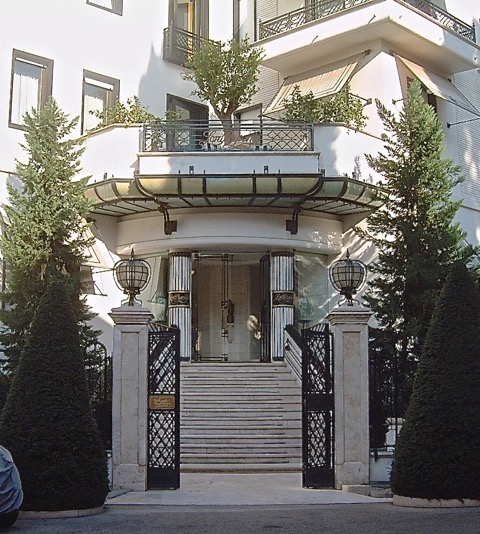 |
|
ENTRANCE TO HOTEL LORD BYRON
|
But remember, mum’s the word!
JANET
STEINBERG is the winner of 40 travel writing awards and a Travel
Consultant with The Travel Authority in Mariemont, Ohio.
STEINBERG is the winner of 40 travel writing awards and a Travel
Consultant with The Travel Authority in Mariemont, Ohio.
